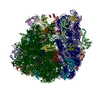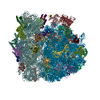[English] 日本語
 Yorodumi
Yorodumi- PDB-6zih: Topological model of p2 virion baseplate in activated conformation -
+ Open data
Open data
- Basic information
Basic information
| Entry | Database: PDB / ID: 6zih | ||||||
|---|---|---|---|---|---|---|---|
| Title | Topological model of p2 virion baseplate in activated conformation | ||||||
 Components Components |
| ||||||
 Keywords Keywords |  VIRAL PROTEIN / lactococcal siphophage p2 / VIRAL PROTEIN / lactococcal siphophage p2 /  baseplate / receptor-binding protein / Distal Tail protein / Tail-associated lysin baseplate / receptor-binding protein / Distal Tail protein / Tail-associated lysin | ||||||
| Function / homology |  Function and homology information Function and homology informationsymbiont genome ejection through host cell envelope, long flexible tail mechanism / virus tail, baseplate / virus tail / entry receptor-mediated virion attachment to host cell /  cell adhesion / symbiont entry into host cell / virion attachment to host cell cell adhesion / symbiont entry into host cell / virion attachment to host cellSimilarity search - Function | ||||||
| Biological species |  Lactococcus phage p2 (virus) Lactococcus phage p2 (virus) | ||||||
| Method |  ELECTRON MICROSCOPY / ELECTRON MICROSCOPY /  single particle reconstruction / single particle reconstruction /  negative staining / Resolution: 28.7 Å negative staining / Resolution: 28.7 Å | ||||||
 Authors Authors | Spinelli, S. / Cambillau, C. / Goulet, A. | ||||||
 Citation Citation |  Journal: Viruses / Year: 2020 Journal: Viruses / Year: 2020Title: Structural Insights into Lactococcal Siphophage p2 Baseplate Activation Mechanism. Authors: Silvia Spinelli / Denise Tremblay / Sylvain Moineau / Christian Cambillau / Adeline Goulet /   Abstract: Virulent phages infecting , an industry-relevant bacterium, pose a significant risk to the quality of the fermented milk products. Phages of the Skunavirus genus are by far the most isolated ...Virulent phages infecting , an industry-relevant bacterium, pose a significant risk to the quality of the fermented milk products. Phages of the Skunavirus genus are by far the most isolated lactococcal phages in the cheese environments and phage p2 is the model siphophage for this viral genus. The baseplate of phage p2, which is used to recognize its host, was previously shown to display two conformations by X-ray crystallography, a rested state and an activated state ready to bind to the host. The baseplate became only activated and opened in the presence of Ca. However, such an activated state was not previously observed in the virion. Here, using nanobodies binding to the baseplate, we report on the negative staining electron microscopy structure of the activated form of the baseplate directly observed in the p2 virion, that is compatible with the activated baseplate crystal structure. Analyses of this new structure also established the presence of a second distal tail (Dit) hexamer as a component of the baseplate, the topology of which differs largely from the first one. We also observed an uncoupling between the baseplate activation and the tail tip protein (Tal) opening, suggesting an infection mechanism more complex than previously expected. | ||||||
| History |
|
- Structure visualization
Structure visualization
| Movie |
 Movie viewer Movie viewer |
|---|---|
| Structure viewer | Molecule:  Molmil Molmil Jmol/JSmol Jmol/JSmol |
- Downloads & links
Downloads & links
- Download
Download
| PDBx/mmCIF format |  6zih.cif.gz 6zih.cif.gz | 270 KB | Display |  PDBx/mmCIF format PDBx/mmCIF format |
|---|---|---|---|---|
| PDB format |  pdb6zih.ent.gz pdb6zih.ent.gz | 210.4 KB | Display |  PDB format PDB format |
| PDBx/mmJSON format |  6zih.json.gz 6zih.json.gz | Tree view |  PDBx/mmJSON format PDBx/mmJSON format | |
| Others |  Other downloads Other downloads |
-Validation report
| Arichive directory |  https://data.pdbj.org/pub/pdb/validation_reports/zi/6zih https://data.pdbj.org/pub/pdb/validation_reports/zi/6zih ftp://data.pdbj.org/pub/pdb/validation_reports/zi/6zih ftp://data.pdbj.org/pub/pdb/validation_reports/zi/6zih | HTTPS FTP |
|---|
-Related structure data
| Related structure data |  11226MC  6zigC  6zjjC M: map data used to model this data C: citing same article ( |
|---|---|
| Similar structure data |
- Links
Links
- Assembly
Assembly
| Deposited unit | 
|
|---|---|
| 1 |
|
- Components
Components
| #1: Protein | Mass: 34511.992 Da / Num. of mol.: 12 / Source method: isolated from a natural source / Source: (natural)  Lactococcus phage p2 (virus) / References: UniProt: D3WAD3 Lactococcus phage p2 (virus) / References: UniProt: D3WAD3#2: Protein |  Tripod (photography) / Gene product 16 / Gp16 / Tail-associated lysine-like protein / Coordinate model: Cα atoms only Tripod (photography) / Gene product 16 / Gp16 / Tail-associated lysine-like protein / Coordinate model: Cα atoms onlyMass: 42883.266 Da / Num. of mol.: 3 / Source method: isolated from a natural source / Source: (natural)  Lactococcus phage p2 (virus) / References: UniProt: D3KFX4 Lactococcus phage p2 (virus) / References: UniProt: D3KFX4#3: Protein |  Receptor (biochemistry) / RBP / Gene product 18 / Gp18 / Coordinate model: Cα atoms only Receptor (biochemistry) / RBP / Gene product 18 / Gp18 / Coordinate model: Cα atoms onlyMass: 28668.057 Da / Num. of mol.: 18 / Source method: isolated from a natural source / Source: (natural)  Lactococcus phage p2 (virus) / References: UniProt: Q71AW2 Lactococcus phage p2 (virus) / References: UniProt: Q71AW2 |
|---|
-Experimental details
-Experiment
| Experiment | Method:  ELECTRON MICROSCOPY ELECTRON MICROSCOPY |
|---|---|
| EM experiment | Aggregation state: PARTICLE / 3D reconstruction method:  single particle reconstruction single particle reconstruction |
- Sample preparation
Sample preparation
| Component | Name: Lactococcus virus P2 / Type: VIRUS / Entity ID: all / Source: NATURAL |
|---|---|
| Molecular weight | Experimental value: NO |
| Source (natural) | Organism:  Lactococcus virus P2 Lactococcus virus P2 |
| Details of virus | Empty: NO / Enveloped: NO / Isolate: STRAIN / Type: VIRION |
| Natural host | Organism: Lactococcus lactis |
| Buffer solution | pH: 7.5 |
| Specimen | Embedding applied: NO / Shadowing applied: NO / Staining applied : YES / Vitrification applied : YES / Vitrification applied : NO : NO |
| EM staining | Type: NEGATIVE / Material: uranyl acetate |
- Electron microscopy imaging
Electron microscopy imaging
| Experimental equipment |  Model: Tecnai Spirit / Image courtesy: FEI Company |
|---|---|
| Microscopy | Model: FEI TECNAI SPIRIT |
| Electron gun | Electron source : LAB6 / Accelerating voltage: 120 kV / Illumination mode: SPOT SCAN : LAB6 / Accelerating voltage: 120 kV / Illumination mode: SPOT SCAN |
| Electron lens | Mode: BRIGHT FIELD Bright-field microscopy Bright-field microscopy |
| Image recording | Electron dose: 25 e/Å2 / Film or detector model: OTHER |
- Processing
Processing
| EM software |
| ||||||||||||||||||||||||||||||||||||
|---|---|---|---|---|---|---|---|---|---|---|---|---|---|---|---|---|---|---|---|---|---|---|---|---|---|---|---|---|---|---|---|---|---|---|---|---|---|
CTF correction | Type: PHASE FLIPPING AND AMPLITUDE CORRECTION | ||||||||||||||||||||||||||||||||||||
| Particle selection | Num. of particles selected: 293 | ||||||||||||||||||||||||||||||||||||
| Symmetry | Point symmetry : D6 (2x6 fold dihedral : D6 (2x6 fold dihedral ) ) | ||||||||||||||||||||||||||||||||||||
3D reconstruction | Resolution: 28.7 Å / Resolution method: FSC 0.143 CUT-OFF / Num. of particles: 261 / Symmetry type: POINT | ||||||||||||||||||||||||||||||||||||
| Atomic model building | Protocol: RIGID BODY FIT | ||||||||||||||||||||||||||||||||||||
| Atomic model building | PDB-ID: 2X53 |
 Movie
Movie Controller
Controller










 PDBj
PDBj

